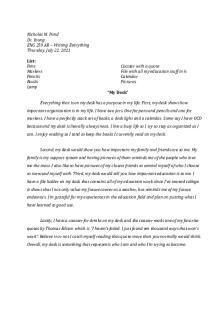Help Desk Understanding Bits and Bytes PDF

| Title | Help Desk Understanding Bits and Bytes |
|---|---|
| Course | A First Course in Computing |
| Institution | Texas Woman's University |
| Pages | 3 |
| File Size | 210.4 KB |
| File Type | |
| Total Downloads | 53 |
| Total Views | 138 |
Summary
Binary language, units of measure, and computer processing...
Description
Help Desk: Understanding Bits and Bytes Monday, February 19, 2018 2:35 PM
Binary Language In order to process data, computers need to work in a language they understand. This is called binary language, consists of two digits: 0 and 1 Everything a computer does, such as process data or print a report, is broken down into a series of 0s and 1s o Each 0 and 1 is a binary digit, or bit o 8 binary digits (or bits) combine to create one byte In computers, each letter of the alphabet, each number, and each special character (like the @ sign) consists of a unique combinations of 8 bits, or a string of 8 1s and 0s EX: the letter K is represented as 01001011. This equals 8 bits, or one byte Unites of Measure: KB, MB, GB, and Beyond Bits and bytes also are what the computer uses to represent the data and information is inputs and outputs o Word processing files, digital pictures, and even software are represented inside a computer as a series of bits and bytes A kilobyte or KB is about 1000 bytes, a megabyte or MB is about one million bytes, and a gigabyte or GB is about one billion bytes o Personal computers store terabytes (TB) of data (about 1 trillion bytes), and many business companies can store up to a petabyte (PB) of data (1000 terabytes) Computer Processing A computer is a processing device that performs four major function, including processing data into information Processor speed is measured in units of hertz (Hz) Hertz means " machine cycles per second" o A machine cycle is the process of the CPU getting the data or information from RAM and decoding the instructions into something the computer can understand o After decoding, the CPU executes and stores the results back into system memory as the last step of the machine cycle Number of cores a processor has, as well as cache memory and front side bus (FSB), determine overall power of the processor Data and Information Data is the representation of a fact, a figure, or an idea o Data can be a number, a word, a picture, or even a recording of sound Computers are good at processing data into information Information is data that has been organized or presented in a meaningful fashion o Data supplied to the computer (name, phone number, address, photo) have been processed appropriately so that it could be printed on an ID card Organized output of data on an ID card is useful information The information can be stored as digital data on the computer for later use Summary
In order to process data into information, computers use binary language, which consists of two digits: 0 and 1. Each 0 and 1 is a binary digit, or bit for short. In computers, each letter, number, or special character consists of a unique combination of eight bits, or one byte. Kilobytes, megabytes, gigabytes, terabytes, and petabytes are amounts of bytes. Strictly defined, a computer is a data processing device that performs four major functions, including processing data into information....
Similar Free PDFs

Understanding Bits and Bytes
- 2 Pages

Soporte Técnico Help Desk
- 6 Pages

Bio Bytes
- 7 Pages

Deel II - Desk Research
- 9 Pages

32 y 64 bits
- 2 Pages

Bio Bytes Notes
- 17 Pages

Understanding packs and bundles
- 5 Pages

My desk - Grade: A
- 1 Pages

Understanding Hazards and Risk
- 45 Pages
Popular Institutions
- Tinajero National High School - Annex
- Politeknik Caltex Riau
- Yokohama City University
- SGT University
- University of Al-Qadisiyah
- Divine Word College of Vigan
- Techniek College Rotterdam
- Universidade de Santiago
- Universiti Teknologi MARA Cawangan Johor Kampus Pasir Gudang
- Poltekkes Kemenkes Yogyakarta
- Baguio City National High School
- Colegio san marcos
- preparatoria uno
- Centro de Bachillerato Tecnológico Industrial y de Servicios No. 107
- Dalian Maritime University
- Quang Trung Secondary School
- Colegio Tecnológico en Informática
- Corporación Regional de Educación Superior
- Grupo CEDVA
- Dar Al Uloom University
- Centro de Estudios Preuniversitarios de la Universidad Nacional de Ingeniería
- 上智大学
- Aakash International School, Nuna Majara
- San Felipe Neri Catholic School
- Kang Chiao International School - New Taipei City
- Misamis Occidental National High School
- Institución Educativa Escuela Normal Juan Ladrilleros
- Kolehiyo ng Pantukan
- Batanes State College
- Instituto Continental
- Sekolah Menengah Kejuruan Kesehatan Kaltara (Tarakan)
- Colegio de La Inmaculada Concepcion - Cebu






